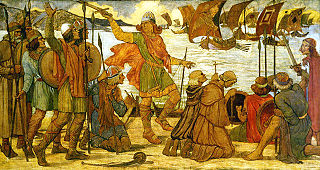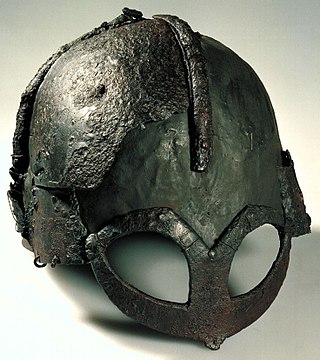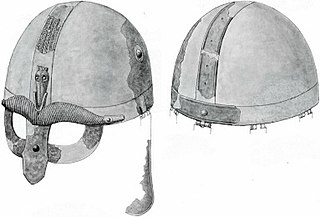
Vikings were seafaring people originally from Scandinavia, who from the late 8th to the late 11th centuries raided, pirated, traded and settled throughout parts of Europe. They also voyaged as far as the Mediterranean, North Africa, the Middle East, Greenland, and Vinland. In their countries of origin, and some of the countries they raided and settled in, this period is popularly known as the Viking Age, and the term "Viking" also commonly includes the inhabitants of the Scandinavian homelands as a whole. The Vikings had a profound impact on the early medieval history of Scandinavia, the British Isles, France, Estonia, and Kievan Rus'.

Yarm, also referred to as Yarm-on-Tees, is a market town and civil parish in the Borough of Stockton-on-Tees, North Yorkshire, England. It is in Teesdale with a town centre on a small meander of the River Tees. To the south-east, it extends to the River Leven, to the south it extends into the Kirklevington.

Knowledge about military technology of the Viking Age is based on relatively sparse archaeological finds, pictorial representations, and to some extent on the accounts in the Norse sagas and laws recorded in the 12th–14th century.

Preston Park is a 100-acre (0.40 km2) public park in Preston-on-Tees, England. It hosts multiple events each year and is located next to the River Tees.

Kirklevington is a village in the borough of Stockton-on-Tees, North Yorkshire, England. At the 2011 census, the village had a population of 809.

Anglo-Saxon art covers art produced within the Anglo-Saxon period of English history, beginning with the Migration period style that the Anglo-Saxons brought with them from the continent in the 5th century, and ending in 1066 with the Norman Conquest of England, whose sophisticated art was influential in much of northern Europe. The two periods of outstanding achievement were the 7th and 8th centuries, with the metalwork and jewellery from Sutton Hoo and a series of magnificent illuminated manuscripts, and the final period after about 950, when there was a revival of English culture after the end of the Viking invasions. By the time of the Conquest the move to the Romanesque style is nearly complete. The important artistic centres, in so far as these can be established, were concentrated in the extremities of England, in Northumbria, especially in the early period, and Wessex and Kent near the south coast.

The Benty Grange helmet is an Anglo-Saxon boar-crested helmet from the seventh century AD. It was excavated by Thomas Bateman in 1848 from a tumulus at the Benty Grange farm in Monyash in western Derbyshire. The grave had probably been looted by the time of Bateman's excavation, but still contained other high-status objects suggestive of a richly furnished burial, such as the fragmentary remains of a hanging bowl. The helmet is displayed at Sheffield's Weston Park Museum, which purchased it from Bateman's estate in 1893.

The Cuerdale Hoard is a hoard of more than 8,600 items, including silver coins, English and Carolingian jewellery, hacksilver and ingots. It was discovered on 15 May 1840 on the southern bank of a bend of the River Ribble, in an area called Cuerdale near Preston, Lancashire, England. The Cuerdale Hoard is one of the largest Viking silver hoards ever found, four times larger than its nearest rival in Britain or Ireland, according to Richard Hall. In weight and number of pieces, it is second only to the Spillings Hoard found on Gotland, Sweden.

The Coppergate Helmet is an eighth-century Anglo-Saxon helmet found in York, England. It was discovered in May 1982 during excavations for the Jorvik Viking Centre at the bottom of a pit that is thought to have once been a well.

The Sutton Hoo helmet is a decorated Anglo-Saxon helmet found during a 1939 excavation of the Sutton Hoo ship-burial. It was buried around the years c. 620–625 CE and is widely associated with an Anglo-Saxon leader, King Rædwald of East Anglia; its elaborate decoration may have given it a secondary function akin to a crown. The helmet was both a functional piece of armour that would have offered considerable protection if ever used in warfare, and a decorative, prestigious piece of extravagant metalwork. An iconic object from an archaeological find hailed as the "British Tutankhamen", it has become a symbol of the Early Middle Ages, "of Archaeology in general", and of England.

The Pioneer Helmet is an Anglo-Saxon boar-crested helmet from the late seventh century found in Wollaston, Northamptonshire, United Kingdom. It was discovered during a March 1997 excavation before the land was to be mined for gravel and was part of the grave of a young man. Other objects in the grave, such as a hanging bowl and a pattern welded sword, suggest that it was the burial mound of a high-status warrior.

The Silverdale Hoard is a collection of over 200 pieces of silver jewellery and coins discovered near Silverdale, Lancashire, England, in September 2011. The items were deposited together in and under a lead container buried about 16 inches (41 cm) underground which was found in a field by a metal detectorist. It is believed to date to around AD 900, a time of intense conflict between the Anglo-Saxons and the Danish settlers of northern England. The hoard is one of the largest Viking hoards ever discovered in the UK. It has been purchased by Lancashire Museums Service and has been displayed at Lancaster City Museum and the Museum of Lancashire in Preston. It is particularly significant for its inclusion of a coin stamped with the name of a previously unknown Viking ruler.

The Shorwell helmet is an Anglo-Saxon helmet from the early to mid-sixth century AD found near Shorwell on the Isle of Wight in southern England. It was one of the grave goods of a high-status Anglo-Saxon warrior, and was found with other objects such as a pattern-welded sword and hanging bowl. One of only six known Anglo-Saxon helmets, alongside those found at Benty Grange (1848), Sutton Hoo (1939), Coppergate (1982), Wollaston (1997), and Staffordshire (2009), it is the sole example to derive from the continental Frankish style rather than the contemporaneous Northern "crested helmets" used in England and Scandinavia.

The Gjermundbu helmet is a Viking Age helmet.

The Bedale Hoard is a hoard of forty-eight silver and gold items dating from the late 9th to early 10th centuries AD and includes necklaces, arm-bands, a sword pommel, hacksilver and ingots. It was discovered on 22 May 2012 in a field near Bedale, North Yorkshire, by metal detectorists, and reported via the Portable Antiquities Scheme. Following a successful public funding campaign, the hoard was acquired by the Yorkshire Museum for £50,000.

The Tjele helmet fragment is a Viking Age fragment of iron and bronze, originally comprising the eyebrows and noseguard of a helmet. It was discovered in 1850 with a large assortment of smith's tools in Denmark, and though the find was sent to the National Museum of Denmark, for 134 years the fragment was mistaken for a saddle mount. In 1984 it was properly identified by an assistant keeper at the museum as the remainder of one of only five known helmets from the Viking era.

The Gevninge helmet fragment is the dexter eyepiece of a helmet from the Viking Age or end of the Nordic Iron Age. It was found in 2000 during the excavation of a Viking farmstead in Gevninge, near Lejre, Denmark. The fragment is moulded from bronze and gilded, and consists of a stylised eyebrow with eyelashes above an oval opening. There are three holes at the top and bottom of the fragment to affix the eyepiece to a helmet. The fragment is significant as rare evidence of contemporaneous helmets, and also for its discovery in Gevninge, an outpost that is possibly connected to the Anglo-Saxon epic Beowulf. It has been in the collection of the Lejre Museum since its discovery, and has been exhibited internationally as part of a travelling exhibition on Vikings.
Elisabeth Munksgaard was a Danish historian and from 1962 until retiring in 1990, the assistant Keeper in the Department of the Prehistory of Denmark at the National Museum of Denmark.} She was "Denmark's acknowledged expert" on art from the late Iron Age and Viking Age.

The Lokrume helmet fragment is a decorated eyebrow piece from a Viking Age Swedish helmet. It is made of iron, the surface of which is decorated with silver and niello that forms an interlaced pattern. Discovered in Lokrume, a small settlement on the island of Gotland, the fragment was first published in 1907 and is in the collection of the Gotland Museum.

The Broe helmet is a decorated iron helmet from around the Vendel Period. Discovered around 1904 in a cremation grave in Broe, a farm on the Swedish island Gotland, it was located alongside other items including fragments of shields, weapons, bridles, and game pieces. Due to its extremely fragmented condition, only an incomplete reconstruction of the helmet is possible, but it appears to have been an example of the "crested helmets" that flourished in England and Scandinavia from the sixth through eleventh centuries.




















